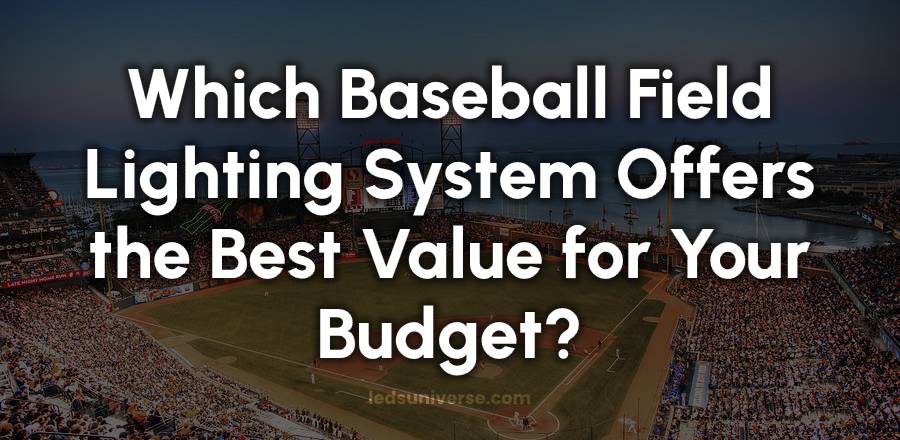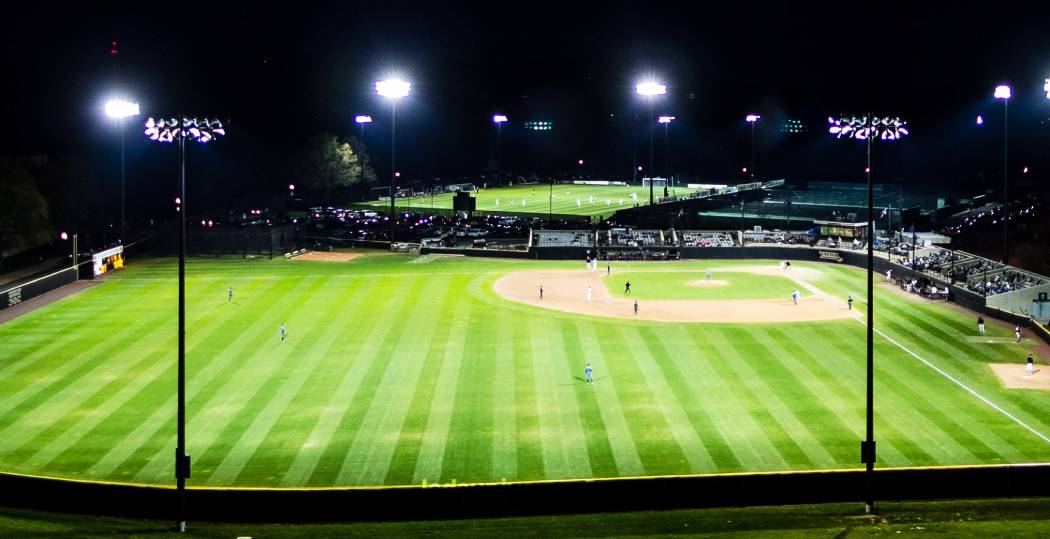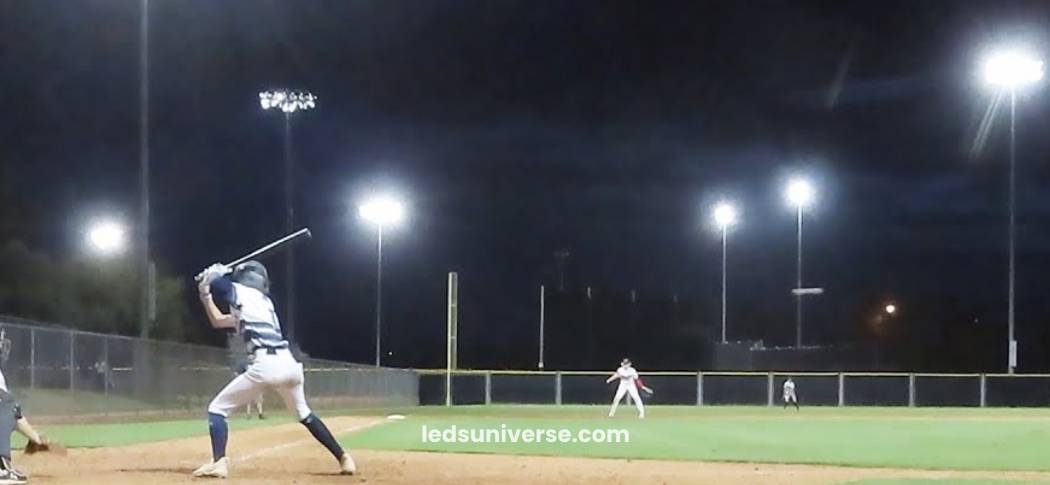
Lighting transforms a baseball field from a daytime playground into a vibrant arena where thrilling games unfold long after dusk. However, bringing that electrifying atmosphere to life comes with its own set of financial considerations. From initial installation expenses to ongoing operational costs, every aspect can significantly impact your budget.
Quality lighting not only allows for games to continue after sunset but also improves visibility and safety on the field. However, the expenses associated with installing and maintaining baseball field lighting can vary widely depending on several factors, including the type of lighting system, installation costs, and ongoing operational expenses. Understanding these costs can aid in effective budgeting and planning for baseball facilities at all levels.
Reach out for free lighting consultation
Table of Contents
ToggleThe first aspect to consider when planning for baseball field lighting is the initial expenses, which encompass the purchase of lighting fixtures, installation costs, and additional equipment necessary for a fully functional lighting system.

| Expense Category | Details | Cost Range |
|---|---|---|
| Purchase of Lighting Fixtures | Number of fixtures required: 8 to 16 Type of lighting: Traditional or LED | $4,000 – $40,000 |
| Installation Costs | Labor costs for installation | $2,000 – $15,000 |
| Additional infrastructure (poles, wiring) | $1,500 – $5,000 | |
| Additional Equipment | Control systems (timers, dimmers) | $500 – $2,000 |
| Safety equipment (fencing around light poles) | $1,000 – $3,000 | |
| Total Initial Expenses | – | $7,600 – $84,200 |
The primary expenditure involves the acquisition of lighting fixtures. As previously mentioned, various options are available, each with its cost implications. For example, a typical baseball field might require 8 to 16 lighting fixtures, depending on its size and the desired level of illumination. Thus, the total expenditure for traditional lighting systems could range from $1,600 to $19,200, while a modern LED system could cost between $4,000 and $40,000.
Organizations must evaluate the specific lighting needs for their fields, considering factors such as field size, desired brightness (typically around 50 to 75 foot-candles for competitive play), and energy efficiency.
Installation costs represent another substantial initial expense. Labor charges for installing lighting systems can vary based on local wage rates and the complexity of the installation. For an average installation, labor costs can run from $2,000 to $15,000, depending on the number of fixtures and the electrical work required.
Properly installing lights requires skilled professionals who understand electrical systems and structural integrity. In some cases, additional infrastructure may be needed, such as poles and wiring, which can add another $1,500 to $5,000 to the overall budget. Depending on the layout of the field and the existing electrical setup, installation expenses can range from a few thousand to tens of thousands of dollars.
Beyond the basic fixtures and installation, additional equipment may be required to ensure the lighting system functions effectively. Control systems, including timers and dimmers, enhance operational flexibility and energy efficiency. The costs associated with these systems can vary but typically add another $500 to $2,000 to the overall budget.
Safety equipment, such as fencing around light poles, is also necessary to protect players and spectators, contributing additional expenses of approximately $1,000 to $3,000. Understanding these initial expenses is fundamental for proper financial planning when developing or upgrading baseball field lighting. A comprehensive analysis of the costs involved helps organizations allocate resources effectively, ensuring that all aspects of the lighting system are considered.
Once the lighting system is installed, ongoing operational expenses must be factored into the overall budget. These expenses include energy costs, maintenance requirements, and insurance considerations that arise from using the lighting system.
The electricity consumption of the lighting system varies based on the type of fixtures installed and the frequency of use. Traditional lighting systems tend to consume more energy, resulting in monthly bills ranging from $300 to $600 for a field used extensively during the season.
For organizations that host numerous games and events, this can lead to substantial expenditures over time. For example, a traditional system may cost around $3,600 annually, while an LED lighting system could reduce this expense to between $1,800 and $2,200, offering savings of approximately $1,400 to $1,800 each year.
Maintenance costs represent another component of operational expenses. Routine maintenance is necessary to keep the lighting system in optimal condition. This includes cleaning fixtures, inspecting wiring, and replacing burnt-out bulbs. Traditional lighting systems may require more frequent bulb replacements, leading to increased maintenance expenses over time.
For instance, a metal halide bulb may need replacing every 1,500 hours of use, which could lead to annual maintenance costs of $1,000 or more. On the other hand, LED systems have a longer lifespan, often exceeding 25,000 hours, and typically require less frequent servicing, resulting in annual maintenance costs of around $300 to $600.
Organizations must budget for these maintenance activities to ensure that the lighting remains reliable and functional throughout the season. Investing in a maintenance schedule that includes regular inspections can help identify potential issues before they become costly repairs.
Repair costs can also impact the overall operational budget. Incidents such as storm damage, vandalism, or electrical failures can lead to unexpected repair expenses. Organizations should prepare for these potential costs by setting aside funds for emergencies, ensuring they can quickly address any issues that arise with the lighting system.
Having a contingency plan in place for repairs can help minimize disruptions to the playing schedule. For instance, setting aside a reserve of about $1,000 to $3,000 annually can provide a buffer for unplanned repair needs. Establishing relationships with local contractors and electricians can also facilitate quicker responses to repair needs, potentially reducing downtime and associated costs.
Organizations often need liability coverage for their facilities, including the lighting systems. The presence of lighting can impact insurance premiums, as any additional safety risks may require higher coverage levels. Evaluating the insurance implications of the lighting system can provide insights into overall operational expenses, helping organizations make informed decisions about their coverage options.
For example, comprehensive insurance coverage for a facility with upgraded lighting may increase annual premiums by $500 to $1,500, depending on the coverage limits and risk assessments. A thorough review of existing insurance policies can ensure that facilities are adequately covered for any potential liabilities associated with the lighting system. Consulting with insurance professionals can help organizations navigate these complexities and find suitable coverage at reasonable rates.
Beyond immediate initial and operational expenses, organizations must consider long-term financial implications associated with their lighting systems. This includes evaluating return on investment (ROI) and planning for the lifespan of the equipment.
Quality lighting can lead to improved game attendance and increased participation, generating additional revenue for the facility. Enhanced visibility and safety can attract more players and spectators, creating a more vibrant community atmosphere.
For instance, if improved lighting leads to an increase in attendance by 20% for a facility hosting 40 games a season, and each ticket sold is $5, the additional revenue generated could reach $4,000 annually. The potential for sponsorship and advertising opportunities also plays a role in ROI. Facilities with well-lit fields may attract local businesses seeking to promote their products and services during games. By offering advertising space on light poles or near the field, organizations can generate additional income, often ranging from $1,000 to $10,000 per season.
Traditional lighting systems, such as metal halide and high-pressure sodium fixtures, generally have shorter lifespans compared to modern LED options. Organizations should factor in depreciation and replacement planning for these systems.
For example, a metal halide fixture might need replacing every 5 to 7 years, with costs ranging from $200 to $1,200 per fixture, leading to potential replacement expenses of $1,600 to $19,200 for an 8 to 16 fixture installation. In contrast, LED lights can last significantly longer, often exceeding 25,000 hours of use, and may only need replacement every 15 to 20 years. This difference impacts both the overall budget and maintenance planning. Organizations can save money in the long term by investing in LED systems, minimizing replacement costs and maintenance efforts.
Exploring case studies of successful lighting installations can provide valuable insights into the financial aspects of baseball field lighting. Various organizations have navigated the complexities of lighting expenses and emerged with effective solutions that meet their needs.
A community sports facility in a mid-sized town recently undertook a lighting upgrade to improve its baseball field. The organization opted for LED lighting due to its energy efficiency and long lifespan. Initial expenses included a $25,000 investment for LED fixtures and installation, significantly higher than the $15,000 cost estimated for traditional lighting options.
However, the facility projected a 50% reduction in energy costs over time, leading to substantial savings that would offset the initial investment. Additionally, the improved lighting attracted more local teams and spectators, resulting in increased participation and revenue generation, with projections of an additional $5,000 to $10,000 in annual income from increased ticket sales and concessions.
Another example can be drawn from a professional baseball team’s decision to upgrade its lighting system. This organization faced pressure to improve game-day experiences and attract larger crowds. They chose a state-of-the-art LED lighting system, which came with a $200,000 price tag, including fixtures and installation.
The team evaluated its ROI based on increased ticket sales and concessions, leading to higher overall revenues. After the upgrade, they reported a 30% increase in attendance, translating to approximately $10,000 to $15,000 more in revenue per season. Additionally, the sponsorship opportunities that arose from having a modern lighting system enabled the organization to generate additional income of around $20,000 per season, further enhancing its financial stability.
These case studies illustrate the importance of analyzing both the initial and ongoing costs associated with baseball field lighting. Organizations can learn from these experiences, tailoring their financial planning to achieve similar success in their facilities.

Securing funding for baseball field lighting projects can pose a challenge for many organizations, especially those operating on tight budgets. However, various funding sources and financial assistance options exist to help alleviate the burden of lighting expenses.
Government agencies and local municipalities often provide funding opportunities for community sports facilities, including baseball fields. These grants may cover a portion of the costs associated with installing new lighting systems or upgrading existing ones.
For example, local sports development grants can range from $5,000 to $50,000, depending on the size and scope of the project. Organizations interested in pursuing grants should research local, state, and federal programs that support sports development and community infrastructure improvement. Submitting a well-prepared grant application can help organizations access financial resources that reduce the overall cost of lighting installations.
Non-profit organizations and foundations may also offer financial assistance for sports facilities. These organizations typically focus on promoting physical activity and community engagement. By aligning the objectives of the lighting project with the mission of the funding organization, facilities may secure necessary resources.
Crafting a compelling narrative about the impact of improved lighting on local sports participation can enhance the chances of receiving support. Engaging with local non-profits and community organizations can also open doors to collaboration and funding opportunities. For instance, a local sports foundation might provide grants ranging from $1,000 to $10,000 for projects that promote youth sports and engagement.
Sponsorship opportunities present another avenue for funding baseball field lighting. Local businesses often seek ways to engage with the community and promote their brand. By establishing partnerships with these businesses, organizations can secure financial contributions in exchange for advertising space on the lighting structures.
This mutually beneficial arrangement not only helps cover lighting expenses but also fosters community relationships. Developing a sponsorship proposal that outlines the benefits for potential sponsors can enhance the likelihood of securing funding. It’s crucial to highlight the exposure sponsors will receive and how their contributions directly benefit the community. Depending on the sponsorship arrangement, organizations can expect contributions ranging from $1,000 to $10,000 annually.
Crowdfunding has emerged as an alternative method for financing community projects, including sports facility improvements. Online platforms allow organizations to share their goals and solicit contributions from community members, local businesses, and sports enthusiasts. By effectively promoting the lighting project and emphasizing its importance to the community, organizations can rally support and generate funds to cover expenses.
Successful crowdfunding campaigns can raise anywhere from $5,000 to $50,000, depending on the outreach efforts and community engagement. Creating engaging content, including videos and testimonials, can enhance the appeal of crowdfunding campaigns. Engaging local media and social media platforms can further amplify outreach efforts, increasing the likelihood of reaching financial goals.
In addition to traditional funding methods, organizations should explore innovative financial models. Collaborating with local schools or recreational leagues can lead to shared costs and resources. Joint ventures can spread the financial burden while enhancing the overall experience for all involved.
For example, a local high school and community sports league might collaborate on a lighting project, sharing costs that could total $100,000. Exploring partnerships with educational institutions may provide access to additional funding sources and a broader base of support. By involving community stakeholders, organizations can create a collaborative approach to funding, leading to shared benefits and reduced expenses.
Understanding the various funding options available for baseball field lighting projects can help organizations navigate the financial landscape effectively. By exploring grants, sponsorship opportunities, and crowdfunding, facilities can secure the resources necessary to install and maintain lighting systems that enhance the game experience for players and fans alike.
Considering the long-term maintenance and potential upgrades to lighting systems is an integral part of financial planning for organizations. Many facilities will require periodic evaluations of their systems to ensure they remain functional and efficient.
Regular inspections, typically conducted bi-annually or annually, can help identify worn-out components or systems in need of cleaning. Organizations might expect to spend about $500 to $1,000 annually for such inspections and minor repairs.
Over time, advancements in lighting technology may prompt facilities to consider upgrades to enhance performance and energy efficiency. Keeping abreast of developments in LED technology and lighting control systems can guide organizations in making informed decisions about when to invest in upgrades. Setting aside a budget of about 10% of the initial lighting investment can be a prudent approach to accommodate future enhancements.
By integrating long-term maintenance and upgrade considerations into financial planning, organizations can avoid unexpected costs and disruptions in their operations, ultimately fostering a more sustainable approach to baseball field lighting.
Effective financial planning for baseball field lighting involves an in-depth analysis of initial and operational expenses as well as identifying potential funding sources. By prioritizing a comprehensive understanding of the financial aspects associated with lighting projects, organizations can ensure they create safe and enjoyable environments for the community while remaining within budgetary constraints.
Exploring various funding options and financial assistance can significantly ease the burden of expenses, allowing facilities to focus on their primary goal: providing a quality baseball experience for players and spectators. Investing in quality lighting not only enhances the playing environment but also fosters community engagement and participation, ultimately benefiting everyone involved.